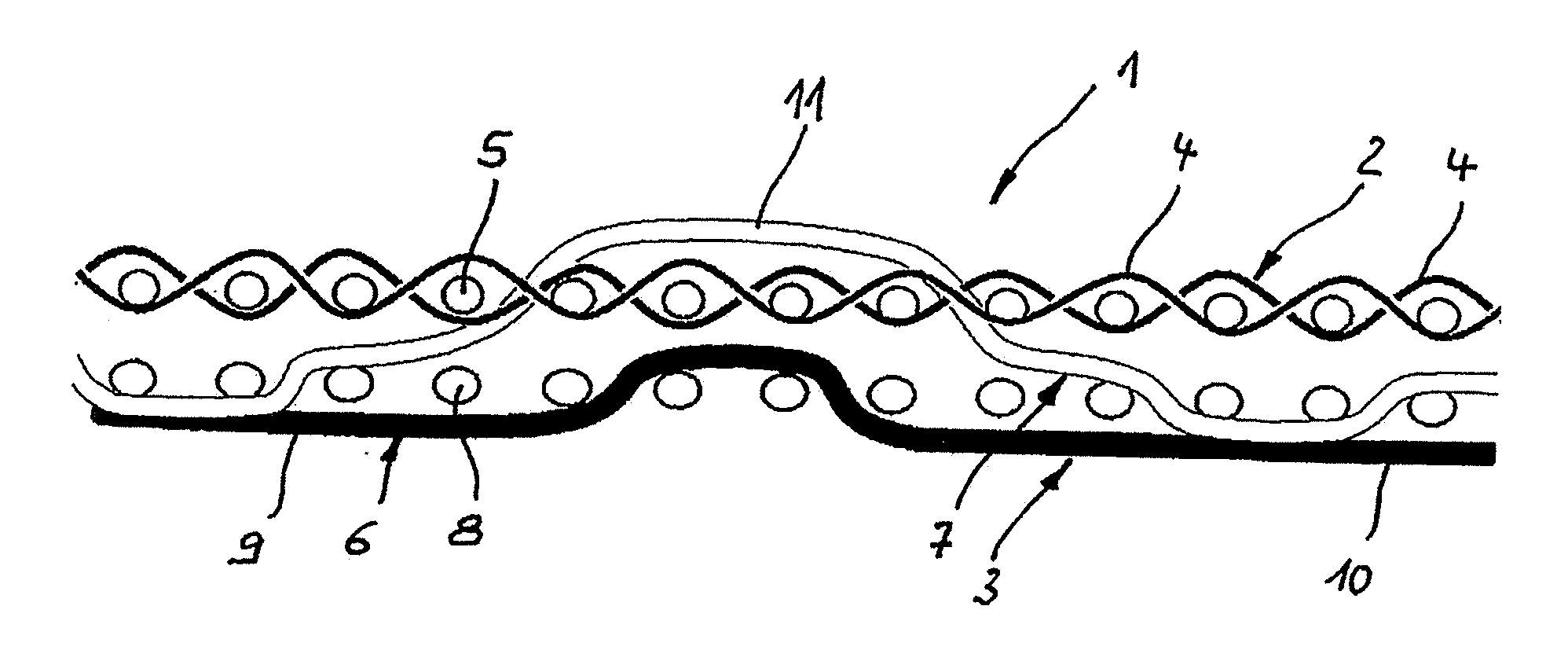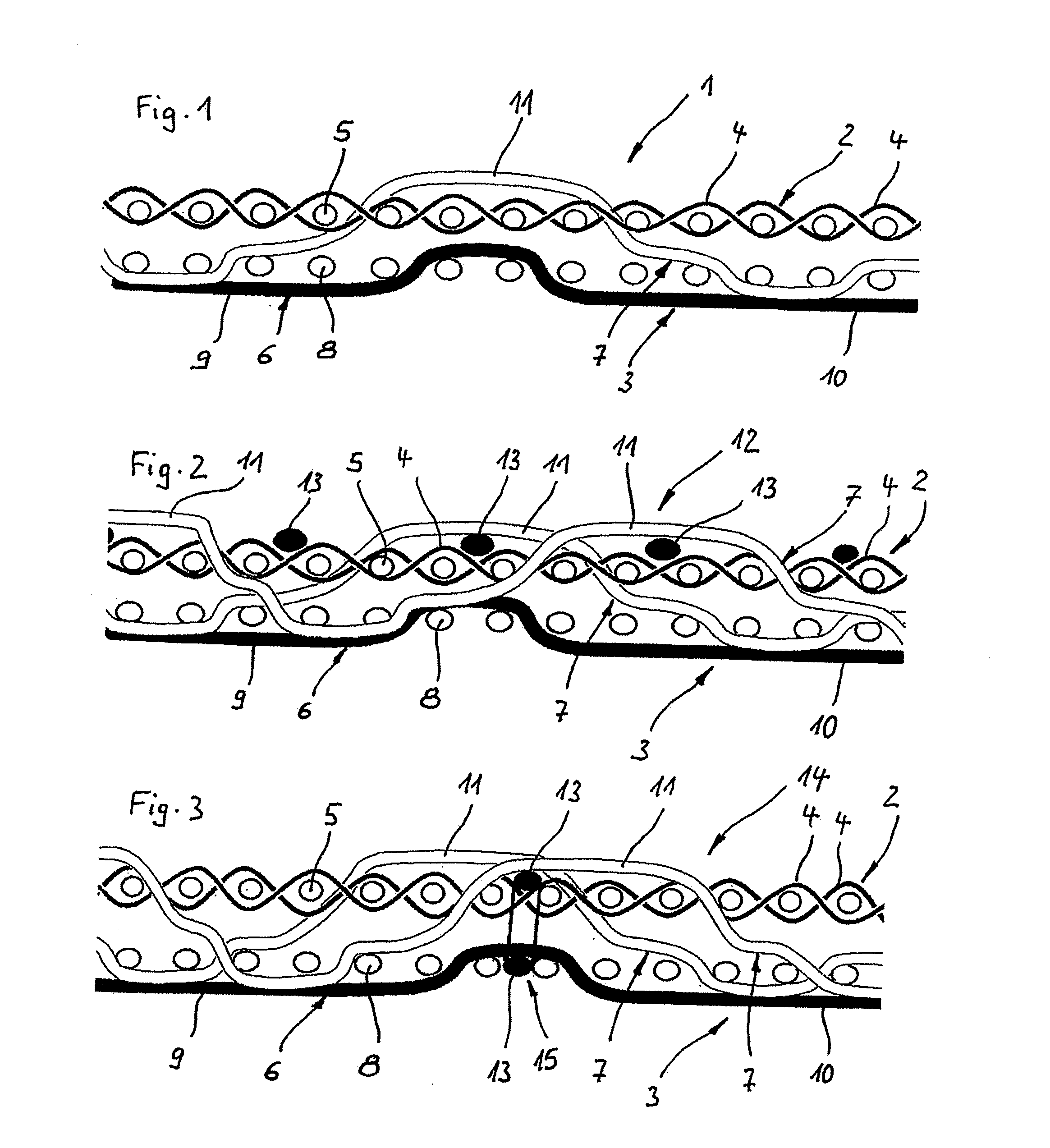Fabric for forming a paper web having an embossed surface
a technology of fibrous paper and embossed surfaces, which is applied in the field of fabric for forming fibrous paper webs with embossed surfaces, can solve the problems of inability to manufacture paper webs with voluminous embossings, affecting the drainage of paper webs, and high cost of fabrics
- Summary
- Abstract
- Description
- Claims
- Application Information
AI Technical Summary
Benefits of technology
Problems solved by technology
Method used
Image
Examples
second embodiment
[0040]the invention shown in FIG. 2 has a similar structure as to the fabric 1 illustrated in FIG. 1. Hence, the same reference numbers are used for the second fabric 12, and it is made reference to the description of the first fabric 1 with respect to the parts provided with the same reference numbers. In FIG. 2, not only one embossing thread 7 is shown but two embossing threads 7 extending adjacently and being offset to one another about three transverse first and second threads 5, 8 such that one transverse first thread 5 is enclosed by two adjacent embossing threads 7, one of which is penetrating in the direction to the paper side and one of which is penetrating in the direction to the second woven fabric layer 3.
[0041]The only difference between the first fabric 1 and the second fabric 12 is that additional transverse third threads 13 are laid over the paper side of the first woven fabric layer 2 between two adjacent transverse first threads 5 respectively. The transverse third...
fourth embodiment
[0045]FIG. 4 shows fabric 16 according to the invention. The fabric 16 is designed similar to the fabrics 1, 12, 14 as shown in the foregoing figures. So, the same reference numbers are used for the according parts of these fabrics 1, 12, 14, and for describing these parts it is referred to the description of the fabrics 1, 12 and 14.
[0046]Fabric 16 is provided with transverse third threads 13, however in this case replacing every sixth transverse first thread 5, being laid onto the first woven fabric layer 2 and hence, not being bound therein. Consequently, all the longitudinal first threads 4 pass under the inner side of the longitudinal third threads 13 thus forming recesses for them. The transverse third threads 13 have an overall cross-section being much thicker than the cross-sections of the transverse first threads 5. The paper side floats 11 of the embossing threads 7 extend first over one transverse third thread 13 after penetrating the first woven fabric layer 2, then pass...
fifth embodiment
[0047]FIG. 5 shows another fabric 21 (fifth embodiment) having a first woven fabric layer 22 and a second woven fabric layer 23 superimposed one over the other.
[0048]The first woven fabric layer 22 comprises longitudinal first threads 24 and transverse threads, namely transverse first threads—for example identified by 25—and transverse third threads—for example identified by 26—, all of which have circular cross-sections. The transverse first threads 25 alternate with the transverse third threads 26. The longitudinal first threads 24 on the one hand and the transverse first and third threads 25, 26 on the other hand are interwoven with one another to form a plain weave, i.e. one longitudinal first thread 24 binds a transverse first thread 25 on its paper side and a subsequent transverse third thread 26 on its inner side, while the adjacent longitudinal first thread 24 binds a transverse first thread 25 on its inner side and a subsequent transverse third thread 26 on its paper side.
[...
PUM
 Login to View More
Login to View More Abstract
Description
Claims
Application Information
 Login to View More
Login to View More - R&D
- Intellectual Property
- Life Sciences
- Materials
- Tech Scout
- Unparalleled Data Quality
- Higher Quality Content
- 60% Fewer Hallucinations
Browse by: Latest US Patents, China's latest patents, Technical Efficacy Thesaurus, Application Domain, Technology Topic, Popular Technical Reports.
© 2025 PatSnap. All rights reserved.Legal|Privacy policy|Modern Slavery Act Transparency Statement|Sitemap|About US| Contact US: help@patsnap.com



